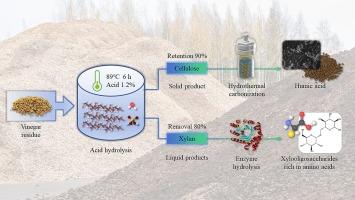释放醋渣的潜力:富含氨基酸的木寡糖和类腐植酸的新型生物炼制战略
IF 7.1
2区 环境科学与生态学
Q1 ENGINEERING, ENVIRONMENTAL
引用次数: 0
摘要
为了解决通过高温水热预处理生产木寡糖(XOS)过程中氨基酸保留率低的问题,我们采用了一种结合低温酸水解和酶水解的新方法。这种创新方法不仅能生产出富含氨基酸的 XOS,还能从醋渣(VR)中获得一种名为类腐植酸(HLA)的宝贵副产品。在最佳预处理条件下(89 °C、6 小时、1.2 % 硫酸),XOS 的产量为 19.88 %。此外,从酸预处理 VR 中提取的水解物中氨基酸含量为 2.65 g/L(相当于 82.0 % 的保留率),样品的 HLA 产率为 10.51 %。傅立叶变换红外光谱、元素分析、总酸性官能团和核磁共振等综合分析表明,所生产的 HLA 与从矿物质中提取的天然商业腐植酸(CHA)的结构和组成相似。通过这种创新方法,从 VR 中生产富含氨基酸的 XOS 和 HLA 提供了一种可持续的解决方案,不仅解决了氨基酸保留率低的问题,还最大限度地发挥了 VR 作为宝贵资源的潜力。本文章由计算机程序翻译,如有差异,请以英文原文为准。

Unlocking the potential of vinegar residue: A novel biorefining strategy for amino acid-enriched xylooligosaccharides and humic-like acid
In order to address the issue of low amino acid retention in the production of xylooligosaccharides (XOS) through hydrothermal pretreatment at high temperatures, a novel approach combining low temperature acid hydrolysis and enzymatic hydrolysis was employed. This innovative method not only allows for the production of amino acid-rich XOS, but also yields a valuable byproduct known as humic-like acid (HLA) from vinegar residue (VR). Under the optimal pretreatment conditions (89 °C, 6 h, 1.2 % sulfuric acid), the yield of XOS was 19.88 %. Furthermore, the hydrolyzate extracted from the acid pretreated VR had a content of 2.65 g/L amino acids (corresponding to the retention rate of 82.0 %), and the HLA yield of the sample was 10.51 %. Comprehensive analyses, such as Fourier transform infrared spectroscopy, elemental analysis, total acidic functional group, and nuclear magnetic resonance were employed to examine the structure and composition of the produced HLA, indicating that it was similar to that of natural commercial humic acid (CHA) extracted from minerals. Through this innovative approach, the production of amino acid-rich XOS and HLA from VR offers a sustainable solution that not only addresses the issue of low amino acid retention but also maximizes the potential of VR as a valuable resource.
求助全文
通过发布文献求助,成功后即可免费获取论文全文。
去求助
来源期刊

Waste management
环境科学-工程:环境
CiteScore
15.60
自引率
6.20%
发文量
492
审稿时长
39 days
期刊介绍:
Waste Management is devoted to the presentation and discussion of information on solid wastes,it covers the entire lifecycle of solid. wastes.
Scope:
Addresses solid wastes in both industrialized and economically developing countries
Covers various types of solid wastes, including:
Municipal (e.g., residential, institutional, commercial, light industrial)
Agricultural
Special (e.g., C and D, healthcare, household hazardous wastes, sewage sludge)
 求助内容:
求助内容: 应助结果提醒方式:
应助结果提醒方式:


